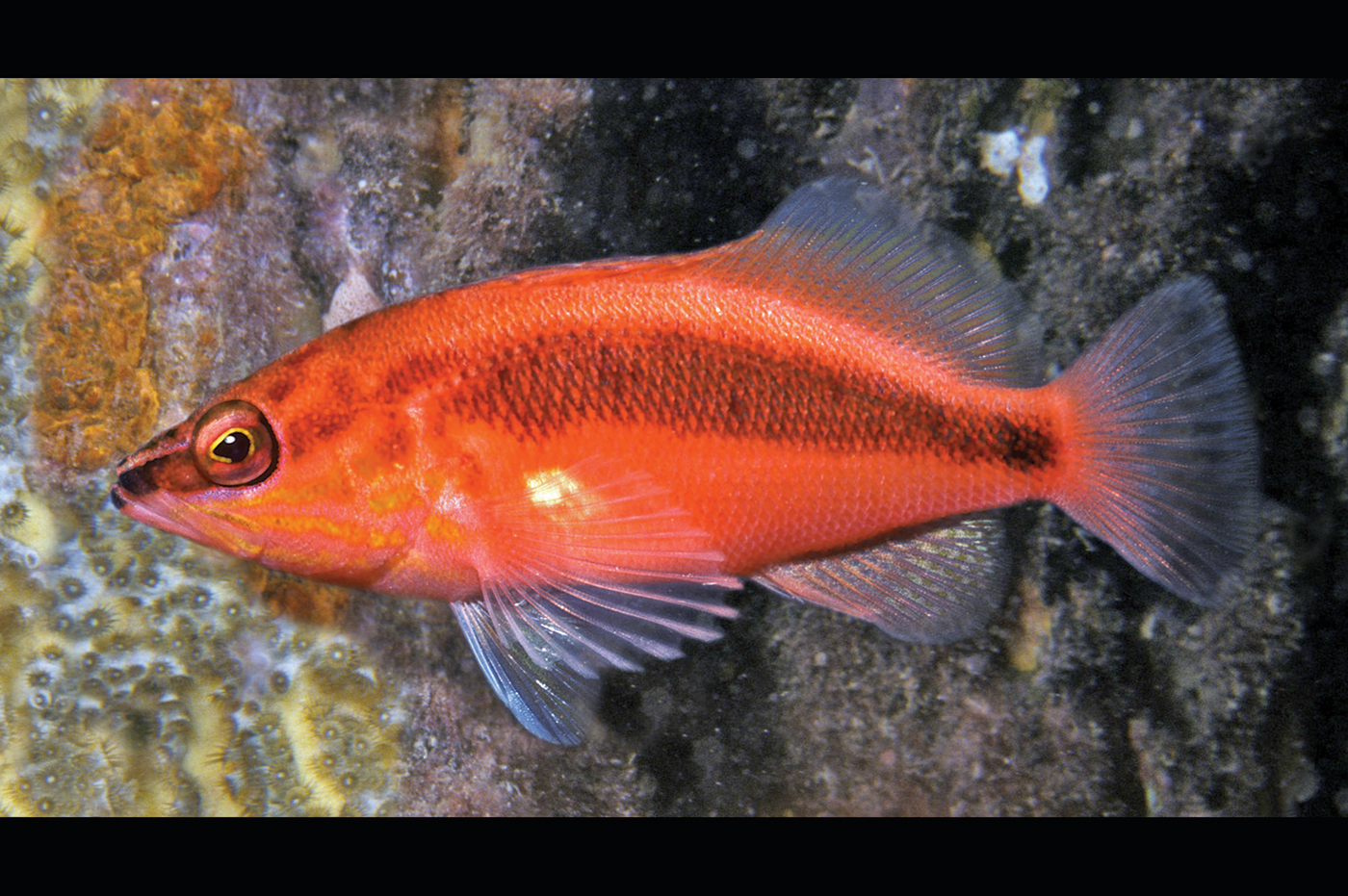Red Seaperch, Hypoplectrodes cardinalis Allen & Randall 1990

Red Seaperch, Hypoplectrodes cardinalis. Source: Rudie H. Kuiter / Aquatic Photographics. License: All rights reserved
Summary:
Pinkish red above, sometimes becoming paler below, with a broad reddish to brown stripe along the upper side from the snout, above each eye, and ending in a dark patch on the caudal peduncle. The species also has yellow stripes across the cheek, and pale pinkish fins.
Cite this page as:
Bray, D.J. 2023, Hypoplectrodes cardinalis in Fishes of Australia, accessed 27 Jun 2025, https://fishesofaustralia.net.au/Home/species/1707
Red Seaperch, Hypoplectrodes cardinalis Allen & Randall 1990
More Info
|
Distribution |
Recherche Archipelago to Shark Bay, Western Australia. Inhabits inshore reefs to depths of 35 m, often sheltering upside-down in caves, crevices and beneath ledges. |
|
Features |
Dorsal fin X,19; Anal fin III,8; Caudal fin 17; Pectoral fin 15–17; Pelvic fin I,5; Gill rakers (lower part of first arch) 8 + 4-5rudiments; Lateral-line scales 41-45; Horizontal scale rows from lateral-line to base of middle dorsal-fin spines 2-3, from lateral- line to anus 17. Body depth 36–40% SL; head length 42–45% SL; eye diameter ~25% HL; preopercles with 3 large forward directed spines on lower edge. Caudal fin rounded; pectoral fins large, reaching beyond origin of anal fin, rounded; pelvic fins small, tips rounded. |
|
Colour |
Head and body generally pinkish-red grading to darker red dorsally; lower portion of head, breast, and abdomen white; prominent red stripe from snout to eye, continued behind eye to upper portion of opercle and two short oblique bands of similar colour and width immediately behind, near upper corner of gill opening; diffuse, dusky brown band running longitudinally on upper sides from upper corner of gill opening to caudal base, more intense posteriorly, forming more or less isolated dark brown spot on caudal peduncle; fins pale pink. |
|
Biology |
Species of the genus Hypoplectrodes are protogynous hermaphrodites, changing sex from female to male during their life cycle. |
|
Etymology |
The specific name is from the Latin cardinalis in reference to the colour of this species, derived from the fact that cardinals of the Catholic Church wore bright red robes. |
|
Species Citation |
Hypoplectrodes cardinalis Allen & Randall 1990, Revue Française d'Aquariologie et Herpétologie 17(2): 45. (nom. nov. for Ellerkeldia rubra Allen 1976, a junior secondary homonym of Scopularia rubra de Buen, 1959). Type locality: Off Beacon Island, Wallabi Group, Houtman Abrolhos Islands, Western Australia, depth 3-4 m. |
|
Author |
Bray, D.J. 2023 |
|
Resources |
Red Seaperch, Hypoplectrodes cardinalis Allen & Randall 1990
References
Allen, G.R. 1976. Descriptions of three new fishes from Western Australia. Journal of the Royal Society of Western Australia 59(1): 24-30 figs 1-3 (described as Ellerkeldia rubra, type locality Beacon Island, Houtman Abrolhos, WA) See ref at BHL
Allen, G.R. & Randall, J.E. 1990. Hypoplectrodes cardinalis, a new name for the serranid fish H. ruber (Allen) from southwestern Australia, with discussion of H. semicinctus from Juan Fernandez Islands. Revue Française d'Aquariologie et Herpétologie 17(2): 45-46 (replacement name for Ellerkeldia rubra Allen, 1976 - a junior secondary homonym of Scopularia rubra de Buen, 1959)
Gill, A.C. 2023. Taxonomic identity of the enigmatic Western Australian fish species Stigmatonotus australis Peters, 1877 (Teleostei). Zootaxa https://doi.org/10.11646/ZOOTAXA.5296.4.4
Hoschke, A., Whisson, G. & Moore, G.I. 2019. Complete list of fishes from Rottnest Island. pp. 150-161 in Whisson, G. & Hoschke, A. (eds) The Rottnest Island fish book. 2nd ed. Perth, Western Australia : Aqua Research and Monitoring Services.
Hoschke, A. & Whisson, G. 2021. The Perth Coast fish book. Identification guide: Mandurah to Two Rocks. Perth, Western Australia : Aqua Research and Monitoring Services, 286 pp.
Hutchins, J.B. 2005. Checklist of marine fishes of Recherche Archipelago and adjacent mainland waters. pp. 425-449 in Wells, F.E., Walker, D.I. & Kendrick, G.A. (eds). Proceedings of the Twelfth International Marine Biological Workshop: The Marine Flora and Fauna of Esperance, Western Australia. Perth : Western Australian Museum.
Hutchins, J.B. & Thompson, M. 1983. The Marine and Estuarine Fishes of South-western Australia. Perth : Western Australian Museum 103 pp. 345 figs.
Kuiter, R.H. 1994. Families Serranidae, Callanthiidae. pp. 528-548 figs 469-485 in Gomon, M.F., Glover, C.J.M. & Kuiter, R.H. (eds). The Fishes of Australia's South Coast. Adelaide : State Printer 992 pp. 810 figs.
Kuiter, R.H. 1996. Guide to Sea Fishes of Australia. A comprehensive reference for divers and fishermen. Sydney, NSW, Australia : New Holland Publishers xvii, 434 pp.
Kuiter, R.H. 2004. Basslets, Hamlets and their relatives. A comprehensive guide to selected Serranidae and Plesiopidae. Chorleywood, UK : TMC Publishing 1, 216 pp.
Peters, W.C.H. 1877. Übersicht der während der von 1874 bis 1876 unter dem Kommando des Hrn. Kapitän z. S. Freiherrn von Schleinitz ausgeführten Reise S.M.S. Gazelle gesammelten und von der Kaiserlichen Admiralität der Königlichen Akadamie der Wissenschaften äbersandte Fische. Monatsberichte der Königlichen Preussischen Akademie der Wissenschaften zu Berlin 1876: 831-854 (described as Stigmatonotus australis, type locality - Dirk Hartog Island, WA, depth 3 fathoms) See ref at BHL
Roberts, C.D. & Gomon, M.F. 2008. Families Polyprionidae, Serranidae and Callanthiidae. pp. 534-549 in Gomon, M.F., Bray, D.J. & Kuiter, R.H. (eds). Fishes of Australia's Southern Coast. Sydney : Reed New Holland 928 pp.





